This is the third part in the JAWS online series of Reflections on Tōhoku
For many of us, images of the 2011 Great East Japan Earthquake (3.11) on coastal Japan—both broadcast live at the time, and subsequently—are seared in our minds; the sights of tsunami waves overrunning seawalls and neighborhoods, and the subsequent massive, coastal construction projects. As an anthropologist with a long history of living and working in coastal Miyagi, I have a personal interest in these changes. Even today, I have a visceral reaction to the massive seawalls that block views of the sea, disrupt human interactions with the coast, and interrupt coastal ecologies. The landscape changes found in these coastal areas today, however, go beyond the building of seawalls and also include the raising of land and flattening of hills and mountains. Witnessing these changes led me to ask myself, “what do these changes mean, if anything, for coastal residents and their culture?” Experiencing an informant crying in an interview as she described the change of scenery from the home she had lived in since birth led me to believe, “possibly, quite a bit.”
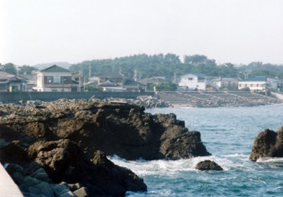
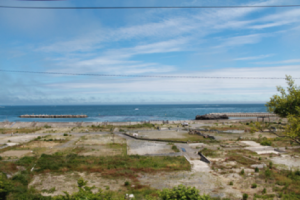

View of the same area from the sea in 2000 (left), the landside in 2011 (center), and in 2017 (right). Source: Alyne Delaney
This essay presents some of my on-going research on landscape change through the lens of place attachment, and I describe some different research methods for tackling what can be a difficult subject. We know that culture develops over time through humans’ interactions with their local environment and can include coevolution (Geertz, 1963). For residents of coastal communities, their environment includes their local land and seascapes, as well as the coastal and ocean waters within which they fish upon and interact. With attachment, people feel connected, often unconsciously, with a place and acquire a sense of identity from living there (Cross et al., 2011). When thinking of disaster contexts, place attachment can be important for community resilience (Berkes and Ross, 2013). Yet changes in the local landscape and society, which include social aspects of place (Masterson et al., 2017) in addition to the landscape, can lead to strong reactions, emotional stress (Jacquet and Stedman, 2014) and anomie. Change over time is inevitable – and natural, as numerous informants have mentioned to me. The scale and means of change, however, can be surprising. The great change wrought on the scenes of coastal Pacific Tohoku, has come not so much from nature, but from government policies put in place in response to the tsunami.
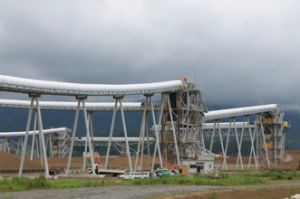

(L) Example of the technology used to flatten and move mountains (2013). Source: Alyne Delaney
(R) The new “Wildvine Hill” neighborhood, after flattening the mountain (2017). Source: City newsletter, UR PRESS Vol.48 March 2017.
My starting point into research on landscape and place attachment, began with this idea of “scenery”. Many wives of the nori (seaweed) fishermen I spoke with talked about how NOT being able to see the sea made them feel “uneasy” (fuan). They highlighted how seeing the sea not only makes it safer for seeing the coming weather and “sea conditions”, but also how seeing the sea helps them feel safe (anshin). The change in landscape, though most noticeable to an outsider through seawalls, is also seen through the designation of hazard zones and the raising and flattening of land and mountains. Throughout the Tohoku Pacific coast, former neighborhoods clustered around small ports and along coastlines, have disappeared under tons of dirt, asphalt, and pine plantations, the latter now relegated to serving as “green spaces”.
Research into these topics began with the standard of anthropological research: the qualitative, ethnographic interview. In this case, open-ended interviewing on innovation post-3.11 with a women’s gardening group brought up, quite forcefully, the impact of landscape change on residents. One local woman (60s) was speaking about her new volunteer activities and, when I asked in 2019 about some of the change she experienced as a result of 3.11, expecting to hear more about her group activities, I was startled to see her start to cry. As she described, “the mountain I saw my entire life is gone… they built ‘New Wildvine’ atop ‘Wildvine Hill’ … From my childhood, I always saw the mountain from my house.”
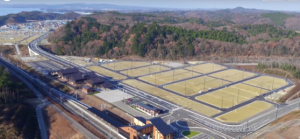
An aerial view of the flattened mountain, prepared for new housing. Both the fore- and
background areas have been flattened from a previously forested mountain.
Source: City newsletter, UR PRESS Vol.48 March 2017
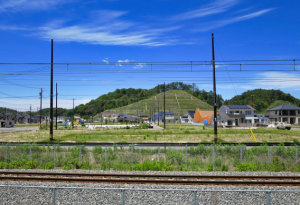
A view of the new construction, with some evidence of a former hill.
Source: Townphoto.net. June 2017
She added later that it was a good decision by the city hall to flatten the mountain to provide housing for misplaced locals, but she didn’t realize its importance to her personally, until it was gone.
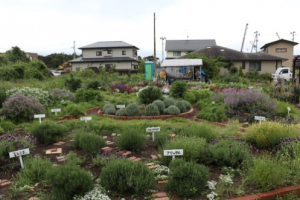
The post-3.11 community garden where the interviews, which first uncovered
the importance of landscape and place attachment, took place.
Source: Alyne Delaney
Much of people’s connection to the coastal landscape is experienced visually, as the example above, but it can also include other senses. Another woman related, “when I was in the emergency shelter, I couldn’t sleep well.” She attributed it to the noise and uncomfortable surroundings, but “after I returned home, I slept very well… I could hear the [ocean] waves. I could sleep well again because I could hear the waves. Until then, I did not understand the connection” (fieldnotes, November 2019). This made me wonder about her former neighbors, now in apartments away from their coastal homes, and how have they adjusted to no longer being able to hear the waves.
During another interview, I pulled out photos I had taken from the front of a home, overlooking a new “green space”, seawall, and ocean. One photo was from before 3.11, the others (2011, 2013-2015, 2018, 2019) were from after. While viewing the photos, she kept commenting on how she had forgotten how much things had changed (during the recovery stage). This reminded me of the importance of prompts such as these photos and I began to contemplate other methods of data collection.
In late 2019, with two British researchers also interested in coastal change, I set up a pilot focus group in my long-term field site. We decided on a two-day workshop which would combine photos, maps, group discussions, and a walking tour. As a pilot workshop, it had its limitations, particularly with the age and gender split of participants (almost all were retired; only 2 men attended), but it was a good experience in teasing out people’s views. We expected a difference according to native and “newcomers”, which we found, but it was subtle. Natives – participants born and raised in the community – tended to speak of their connections to the sea and coast through activities related to the fishing industry, while newcomers (all at least 20 years resident in the area) spoke of the coast as being a nice place to live and showed appreciation for readily available good seafood. Thus, both groups appreciated the natural environment but spoke of it in different terms.

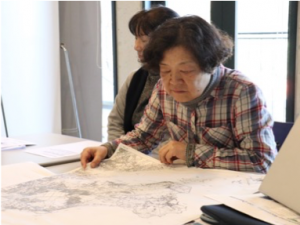
Day one of the Place Attachment workshop. Source: Alyne Delaney
The workshop began with self-introductions and the explanation of what the research was about. We then dove into our themes of “relationships with the sea”, “living with the sea”, and “coastal” defenses”, asking about differences between pre- and post-3.11. During discussions, large maps were pulled out for them to locate places they were speaking about and to help them emphasize certain points. We also had large A4 size photos, but these weren’t utilized much until the second day. For relationship with the “land/seacape” there was a lot of discussion on how society had changed over the years, even before 3.11 with fewer people working in the fisheries. An interesting point was how they believed 3.11 significantly changed families, as many multi-generational households were broken up, with the younger, nuclear families moving to apartments outside of town and the older grandparents staying in temporary housing in town. For “living with the sea”, we found there was a sense of “feeling of resilience” from the community, and that this is their life – they were confident that the tsunami had not influenced how people feel about remaining near the coast. For “perceptions of coastal defenses” there was a general sense of safety, though several mentioned the negative impacts it had on fishers.

Day two: A walking tour atop the seawall, 2019. Source: Alyne Delaney
Day two was the walking tour. These same participants returned to show us the areas they had talked about the day before. They were led by a local district leader who also talked about some of the history. As people came upon certain areas, they spontaneously described memories from their childhood, explained changes, reached for the photos to show some of the changes visually, and also spoke about how some of these differences made them feel. There was also a fair amount of discussion among participants about how much had changed due to 3.11, and how much change was actually a part of an on-going societal shift. In particular, participants (in their 60s) talked about their own childhoods and how they played and interacted with the local nature, while such “free play” activities seem to lessen with each succeeding generation.
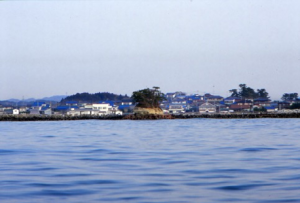
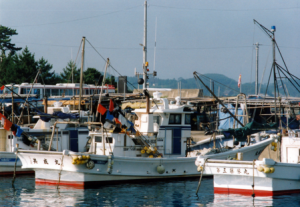
Views of the workshop community from the sea, 2000. Source: Alyne Delaney


Views of the workshop community, 2021. Source: Alyne Delaney
We were heartened by participants’ positive responses to the workshop, and we were gearing up for more when the COVID-19 pandemic hit. We plan for more, however, when conditions allow. This research will provide us with an understanding of the impacts of disaster-impacted change on local communities and cultures. We also hope it can point to the consideration of the importance of landscape and culture when considering planning such as for disaster risk reduction and resilience. Combining these results with other studies, such as Tashiro et al. (2021) who talk about worsened psychological outcomes among those living near hard structure seawalls, can help inform an agenda for “post-disaster life and living”, not just “survival, post-disaster.”
Acknowledgements
Pilot research took place under an ESRC UKRI project “The Political Ecology of Coastal Societies” co-hosted by the University of Aberdeen and Tohoku University. Dr. Emma McKinley (Cardiff University) and Dr. Tavis Potts (University of Aberdeen) showed interest in my work on “post-3.11 community life with seawalls” and so we conducted the first pilot workshop together. We would like to thank the participants for their interest in the project thus far, and look forward to future workshops.
Alyne E. Delaney
Center for Northeast Asian Studies
Tohoku University, Sendai, Japan
alyne.delaney@tohoku.ac.jp
References
Berkes, F., and H. Ross (2013) Community resilience: toward an integrated approach. Society and Natural Resources 26(1):5-20.http://dx.doi.org/10.1080/08941920.2012.736605
City Newsletter (2017) “Come and see the “now” of reconstruction!” UR PRESS Vol.48.
Cross, J.E., Keske, C.M., Lacy, M.G., Hoag, D.L. and Bastian, C.T. (2011) Adoption of conservation easements among agricultural landowners in Colorado and Wyoming: The role of economic dependence and sense of place. Landscape and Urban Planning, 101(1), pp.75-83.
Geertz, C. (1963) Agricultural Involution. University of California Press, Berkeley.
Jacquet, J. B., and R. C. Stedman (2013) Perceived impacts from wind farm and natural gas development in northern Pennsylvania. Rural Sociology 78(4):450-472.
Masterson, V. A., R. C. Stedman, J. Enqvist, M. Tengö, M. Giusti, D. Wahl, and U. Svedin (2017) The contribution of sense of place to social-ecological systems research: a review and research agenda. Ecology and Society 22(1):49.
Tashiro, A., Nakaya, T., Nagata, S., & Aida, J. (2021) Types of coastlines and the evacuees’ mental health: A repeated cross-sectional study in Northeast Japan. Environmental research 196, 110372.


